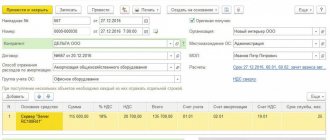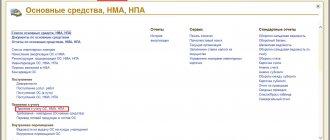Fixed assets (FPE) may be written off over time for various reasons. OSes can simply become unusable, they can be sold or even donated. How to process various asset disposal transactions in accounting, see below.
First of all, any disposal of fixed assets must be documented and all details of the operation must be indicated in the documents.
When the asset is worn out, a write-off act is drawn up, which is signed by members of a specially created commission.
To register the disposal of fixed assets, there are unified forms of acts. The main form is OS-4, it is suitable for the vast majority of OS. If you need to write off a car, use act OS-4a. For group write-off of fixed assets, form OS-4b is used.
Write-off of OS as a result of physical or moral wear and tear
Wear and tear can be physical - this can include the failure of equipment due to a long period of use.
Obsolescence can be moral - for example, computer technology often becomes obsolete, so companies write off obsolete computers and replace them with modern ones.
The write-off of OS due to wear and tear is recorded with the following entries:
Debit 01 subaccount “Disposal” Credit 01 - the original cost is written off;
Debit 02 Credit 01 subaccount “Disposal” - accrued depreciation is written off;
Debit 91 Credit 01 subaccount “Disposal” - the residual value is written off.
How to draw up an order to write off fixed assets
To date, there is no unified, unified and mandatory sample of this document. Therefore, managers of enterprises and organizations can write an order in free form or use a document template that is used within the company (it must be remembered that independently developed document forms must be registered in the company’s internal accounting policies). Regardless of which option is chosen, the order must contain a number of mandatory information . These include:
- full name of the company,
- date and order number,
- Name,
- model,
- brand,
- inventory number,
- as well as the reasons for writing off the fixed asset.
An important nuance: this order may include either one object or a whole group of fixed assets being written off. The second option usually occurs as a result of a planned inventory of the company's property.
Sale of fixed assets
Fixed assets may also be disposed of as a result of sale. For example, you can implement obsolete operating systems. Or, for example, a company decides to update equipment in a workshop and first sells machines that are physically worn out, and then uses the proceeds to purchase new equipment.
When selling a fixed asset, it is important to fill out all the documents correctly and make the correct entries.
It is customary to formalize the sale of OS using OS or OS-1 acts.
Example. OJSC MTZ sells Opel cars. Depreciation for Opel is 231,000 rubles. The initial cost of the Opel car is 783,000 rubles, the residual cost is 552,000 rubles (783,000 - 231,000). The Opel sale price is set at 512,000 rubles.
The accountant of MTZ LLC made the following entries:
Debit 62 Credit 91 - 512,000 - proceeds from the sale of Opel;
Debit 91 Credit 68 - 78,101.69 - VAT on proceeds from the sale of Opel (512,000 x 18/118);
Debit 01 subaccount “Disposal” Credit 01 - 783,000 - the original cost of Opel is written off;
Debit 02 Credit 01 subaccount “Disposal” - 231,000 - depreciation accrued for Opel during the period of operation at MTZ LLC is written off;
Debit 91 Credit 01 subaccount “Disposal” - 552,000 - the residual value of Opel is written off.
Tax reporting on time and without errors! We are giving access for 3 months to Kontur.Ektern!
Try it
Procedure for decommissioning an object
An order to write off fixed assets is created only on the basis of the conclusion of a special commission. She decides what will be written off and what cannot be written off.
You cannot just issue an order - you must have a written basis for this. Usually this is the conclusion of the members of a specially created commission, who, in a separate act, certify the fact of the need to write off the fixed asset for certain circumstances, and also give recommendations on the possibility of practical use of any of its elements in the future.
The commission itself is also appointed by a separate order of the head of the enterprise. It includes at least three people who belong to different structural divisions of the company. At the same time, members of the commission must have the necessary level of knowledge in order to determine the actual unsuitability of a fixed asset item for further use. As a rule, members of the commission are
- Deputy Director,
- Accounting department employee
- financially responsible person (for example, storekeeper)
- and, if necessary, some other highly specialized specialists.
Free transfer (donation) of fixed assets
When transferring free of charge, it is important to charge VAT. You can donate (transfer) the operating system either to your employee or to a third party. The OS must be donated according to the contract. A gratuitous transfer is reflected in accounting at the market value of the fixed assets on the date of donation.
Example. MTZ LLC presented an Opel car to employee of the year A.T. Burov. The Opel car had previously been used by the company for three years. Depreciation for Opel is 231,000 rubles. The initial cost of the Opel car is 783,000 rubles, the residual cost is 552,000 rubles (783,000 - 231,000). The market value of the Opel car on the date of gratuitous transfer is 512,000 rubles.
Postings:
Debit 01 subaccount “Disposal” Credit 01 - 783,000 - original cost written off;
Debit 02 Credit 01 subaccount “Disposal” - 231,000 - accrued depreciation written off;
Debit 91 Credit 01 subaccount “Disposal” - 552,000 residual value written off;
Debit 91 Credit 68 - 92,160 - VAT is charged on the market value (512,000 x 18%).
Liquidation
To determine the possibility of further use of the property, by decision of the company management, a commission is created, which includes persons responsible for the safety of the property, technical specialists, financial workers (clause 77 of Order of the Ministry of Finance 91n dated 10/13/03).
The commission is entrusted with the responsibility of inspecting the facility, making a decision on its liquidation, identifying the reasons for the impossibility of further operation and the persons responsible for this, as well as drawing up a decommissioning act. The write-off act can be developed by the organization independently, or one of the unified forms can be used: OS-4, OS-4a, OS-4b (Resolution of the State Statistics Committee of the Russian Federation 7 of 01.21.03). Based on the act, the object is written off from the register and a mark of disposal is placed on its inventory card.
The residual value of the written-off object is reflected in non-operating expenses in both accounting and tax accounting on the date of the write-off act. Also, non-operating expenses should reflect the costs of dismantling, removal and other actions related to the liquidation of the facility.
The components of the liquidated object, suitable for further use, are accounted for at the current market value, reflected in non-operating income.
Sample order for write-off of fixed assets
Order for inventory of fixed assets
Order for modernization of fixed assets
Order on conservation of fixed assets
Documentary support
In the process of writing off property, the following documents may be drawn up:
| Act OS-1 | Compiled for any OS, with the exception of capital structures. |
| OS-1a | For any immovable structures and buildings. |
| OS-1b | If a group transfer of property is required. |
You may also need forms prepared according to OS 4, 4a and other forms. Thus, it will be necessary to prepare a package of documents confirming the write-off of fixed assets, as well as indicating the presence of arguments related to the inability to use this property in the future.
Other Disclaimers
In addition to these features, there are also several other important nuances that need to be taken into account in the process of writing off fixed assets.
Depreciation process
Depreciation is carried out from the moment the production assets were registered with the organization until the full repayment of the cost or in the case of write-off of fixed assets due to their excessive wear and tear. Any entries made for depreciation charges are made to account 02, while the credit for passive and balance sheet accounts fully reflects the total amount of accruals for the specified object.
By debit, the depreciation amount is written off only in the case of write-off of non-current assets, and the procedure itself can be carried out using the following methods:
- linear;
- write-off due;
- by reducing balance"
- in proportion to the ratio of the volume of production of commercial products.
The choice of methods remains with the enterprise, and must be reflected in the accounting policies. Taking into account the chosen scheme, which is determined on the basis of information about the fund’s inventory objects, this amount is posted on loan 02.
Such expenses can lead to an increase in the cost of property of certain divisions that operate fixed assets.
Trading companies include all depreciation charges in costs.
Defective statement
When preparing a defective statement, you must indicate the following information:
- justification for why this procedure is advisable from an economic point of view;
- a source of information within the company to analyze the reason for the depreciation of fixed assets;
- a document indicating the expert's decision.
This statement contains information confirming the fact that there is no possibility of further operation of fixed assets, which led to the need to write them off.
Service memo
The preparation of a memo should be carried out in accordance with some recommendations:
- on the right side the full name and position of the addressee are indicated;
- You must indicate the title of the document;
- the date and registration number of the note are indicated;
- the specific subject of this document is reflected;
- description of the situation;
- signature of an authorized person.
An official note when writing off fixed assets is required only if the object has suffered wear and tear or its material and technical base is considered obsolete.
Rules for document preparation
An order to write off fixed assets can be written either by hand or in printed form, both on the organization’s letterhead and on a regular A4 sheet.
The most important condition: it must contain “live” signatures of the head of the company and the employees who are mentioned in it.
It is not necessary to certify the order with a seal, since it relates to the internal documentation of the enterprise (let’s not forget that from 2021, legal entities may no longer use seals and stamps in their work to endorse papers).
The order refers to primary documentation, therefore the rules for its storage are strictly regulated. It must be kept in the archives of the enterprise for at least five years, in case it is required by tax specialists (for example, to confirm the write-off of a fixed asset).
An example of drawing up an order
Making a hat
In the “header” of the document, in the middle of the line, the full name of the organization is written, then below after the word “order” its number is written (in accordance with the internal document flow), and also in the required line the locality in which the company operates is noted and the date the order was drawn up is indicated .
Main part of the order
The main part of the document describes
- reason for writing off the fixed asset,
- his name,
- inventory number,
- number according to the technical passport (if necessary),
- and also indicates the employee who is directly responsible for liquidating the object.
If parts, elements, assemblies and parts of a fixed asset can still serve the enterprise, they must be sent to the warehouse, which is also recorded in the order (with the appointment of a materially responsible employee).
The order must indicate the employee who must write off the object from accounting (indicating the position, surname, first name, patronymic of the specialist).
Document approval
Finally, the order must be signed by the head of the enterprise, as well as by all employees who participate in the write-off of fixed assets at its various stages and who are named in this document.






